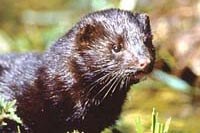
Mink. Photo by Robert Barber, Painet, Inc.
Mink nutrition research began in 1964 after a request from the Pennsylvania Fur Farmers Association to Dean Jackson to make use of about $25,000 that had accumulated in a "research fund" from a portion of license fees earmarked for research on fur animals. Dean Jackson agreed, and R. C. Miller, head of the Animal Industry Department, assigned Emery Keck to lead the project.
Starting from scratch to learn mink ranching, Keck soon found that $25,000 (which never materialized) wouldn't make a start! Mink ranchers insisted that mink would eat only fresh meat products. They all had huge walk-in freezers to store frozen horse carcasses and tons of fish and chicken. Heavy-duty electric-powered slicers, "hogger" grinders, and mixers were needed to prepare daily rations of wet paste from these frozen ingredients.
A Pennsylvania Department of Agriculture grant (Harness Racing Funds - $400,000) provided for the building of facilities at Rock Springs, with capability of pelting about 300 mink annually, with equipment for processing both conventional wet (fresh meat) diets and pelleted dry diets. Dry diets were developed utilizing by-product meal from the Empire Kosher Poultry Processing Plant, which contained about 20% whole-bird carcasses due to severity of the Kosher inspection.
The best of the dry diets produced pelts nearly as large and equal in value to those on the conventional wet diets at less than half the feed costs, eliminating the expensive physical plant needed for processing, and sanitation problems associated with spoilage of uneaten food. Because the major fur processors had already invested in the conventional system, they were not pleased with the findings that would encourage competition of lower-cost operations. Their loss of interest and the political changes that came about with the 1972 election resulted in the demise of the project.
Author: Robert L. Cowan, Professor of Animal Nutrition

